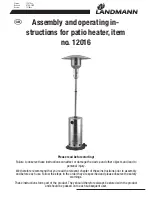
Explosion hazard.
Any heater installed with restrictive devices in the piping system
downstream from the heater, (including check valves, isolation valves, flow nozzles, or
therapeutic pool valving), must have a relief valve installed as described above.
!
WARNING
Fire or flooding hazard.
If the unit overheats and the burner fails to shut off, follow
instructions under “To Turn Off Gas to the Appliance”, page 36, and call a qualified service
technician to repair unit.
!
WARNING
After start-up, the outlet water pipe should feel slightly warmer than the inlet pipe. If it feels
hot, or if you hear the water in the heater boiling, there may not be enough water flow to the
appliance. Make sure that the filter is not plugged. If water temperature remains high but the
unit continues to operate, turn off the appliance and call your service technician.
SPRING AND FALL OPERATION
If the pool is only used occasionally, lower the pool thermostat to 20° C (68° F) and leave the
heater on. This will keep the pool and the surrounding ground warm enough so that the heater
should restore the pool to a comfortable temperature within about one day.
PRESSURE RELIEF VALVE
Local codes may require installation of a pressure relief
valve (PRV). Purchase separately and install a 19 mm
pressure relief valve complying with the local Plumbing
Codes, having a capacity equal to the Mega Joule (MJ/hr)
rating of the heater. The relief pressure of the valve MUST
NOT EXCEED 344 kPa.
The relief valve must be installed vertically. To install the
valve, use a 19 mm x 5 mm brass nipple at the manifold,
the two brass elbows and nipples are (user supplied), as
illustrated in Figure 35. No valve is allowed to be placed
between the manifold adapter and the relief valve.
To avoid water damage or scalding from operation of the
relief valve, install a drain pipe in the outlet of the pressure
relief valve that will direct water discharging from the valve
to a safe place for disposal. Do not install any reducing
couplings or valves in the drain pipe. The drain pipe must
be installed so as to allow complete drainage from the valve
and drain line.
The relief valve should be tested at least
once a year by lifting the valve lever.
Drill thru the NPT Port, then
use a 19 mm Brass Nipple and
Elbow (user supplied) for a
PRV Installation.
Figure 35.
AFTER START-UP
CHECKING WATER FLOW











































